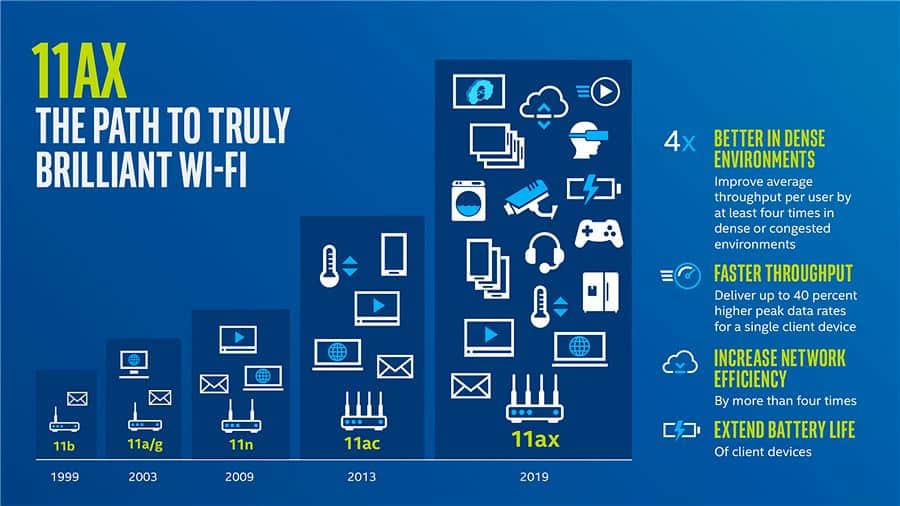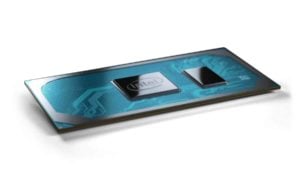The new 802.11 ax Wi-Fi technology standard is named as WiFi 6 by WiFi Alliance. The technology was announced and introduced in April 2018, with its main feature supporting 10Gbps speeds, it is almost 10 times faster than the previous generation.
The first Smartphone to use this new WiFi standard is the Samsung Galaxy Note 10. While for laptops has also been present, it's for those who use the new 10th generation Intel processors, Ice Lake and Comet Lake. The first Laptop to use an Intel 10th generation CPU (and therefore can support WiFi 6) is the Dell XPS 13 2-in-1.
Of course Wifi 6 complements other wireless technologies that offer enhanced range, speed and a more reliable performance of Wifi 5. That may not be enough, Wifi 6 is also power saving, this is because the signal will be disconnected when not in use.

In addition, WiFi 6 emphasizes quality connectivity with network efficiency and lower latency for uplink and downlink traffic. And it can run optimally on high demand conditions, up to hundreds or thousands of connected devices.
New technologies that support WiFi 6 are designed to handle data delivery more efficiently, and provide faster but also consistent access to download and upload speeds, especially on dense network usage.
Faster and safer. Wifi 6 meets the highest standards of security and interoperability, with the latest generation of advanced security levels WPA3-personal. Who can see a simpler WiFi user and password.
Other capabilities of WPA3 are resistant to offline dictionary attacks or offline dictionary attacks, where enemies try to determine the network password by trying possible passwords without further network interaction.

- Better in dense environments: increase the average throughput per user by at least four times in a dense or dense environment
- Faster Throughput: delivers the highest peak data rate up to 40 percent for single client devices
- Improve network efficiency: more than four times
- Extends battery life: on client devices
WiFi Network Order
| Original name | New name | Top speed | Year Introduction | Other information |
| 802.11 ax | Wi-Fi 6 | 10Gbps | 2018 | Designed to operate in both 1 and 7 GHz frequencies as well as 2.4 GHz and 5GHz |
| 802.11 ac Wave 1/Wave 2 | Wi-Fi 5 | 1.3 Gbps/2.34 Gbps | 2013/2016 | Used channels 20, 40 and 80-MHz in the band 5GHz/channel 160MHz 5GHz, adding MU-MIMO (Multi-user MIMO) for greater coverage |
| 802.11 n | Wi-Fi 4 | 450Mbps | 2009 | Support for dual-band Wi-Fi, meaning routers and devices can use both 2.4 GHz and 5GHz, and MIMO (input mutli, multi output) for larger coverage |
| 802.11 g | T/A | 54Mbps | 2003 | Brings the top 802.11 a speed to the 2.4 GHz frequency |
| 802.11 b | T/A | 11Mbps | 1999 | Single-Band, using 2.4 GHz frequency |
| 802.11 a | T/A | 54Mbps | 1999 | Single-band, uses 5GHz frequency, launched at the same time with 802.11 b |
802.11 n vs. 802.11 ac vs. 802.11 ax
| 802.11 n (Wi-Fi 4) | 802.11 ac Wave 2 (Wi-Fi 5) | 802.11 ax (Wi-Fi 6) | |
| Released | 2009 | 2013 | 2019 |
| Band | 2.4 GHz & 5GHz | 5GHz | 2.4 GHz & 5GHz, reaching 1GHz-7GHz finally |
| Channel Bandwidth | 20MHz, 40MHz (optional 40MHz) | 20MHz, 40MHz, 80MHz, 80 + 80MHz & 160MHz (mandatory 40MHz support) | 20MHz/40MHz @ 2.4 GHz, 80MHz, 80 + 80MHz & 160MHz @ 5GHz |
| FFT size | 64, 128 | 64, 128, 256, 512 | 64, 128, 256, 512, 1024, 2048 |
| Subcarrier distance | 312.5 kHz | 312.5 kHz | 78.125 kHz |
| OFDM symbol duration | 3.6 MS (short guard interval) 4ms (long guard interval) | 3.2 ms (cyclic prefix 0.4/0.8 ms) | 12.8 ms (cyclic prefix 0.8/1.6/3.2 ms) |
| Highest modulation | 64-QAM | 256-QAM | 1024-QAM |
| Data speed | Starting from 54Mb/s to 600Mb/s (max. 4 spatial flows) | 433Mb/S (80MHz, 1 spatial stream) 6933Mb/s (160MHz, 8 spatial streams) | 600Mb/S (80MHz, 1 spatial stream) 9607.8 Mb/S (160MHz, 8 spatial streams) |
| SU/MU-MIMO-OFDM/A | SU-MIMO-OFDM | SU-MIMO-OFDM Wave 1, MU-MIMO-OFDM Wave 2 | MU-MIMO-OFDMA |
It takes the right equipment to make full use of WiFi 6 and its upgrades. The router is 802.11 ax compatible and any device connected to the router must have a corresponding WiFi 6 antenna.
The Wi-Fi standard also ensures that the product is compatible with its predecessor. In other words, the old device will still be able to connect to the WiFi router 6. But will not be able to utilize the new capabilities of Wifi 6. Likewise, smartphones, laptops, and other devices compatible with WiFi 6 can connect to the router using WiFi 5.
What is a 5GHz Wi-Fi? Is it the same between 5G with WiFi 5?
Not. Since its inception, Wi-Fi has used two radio frequencies-2, 4GHz or 5GHz.
The 2.4 GHz frequency is pretty much used. Bluetooth, other wireless technology standards also use the 2.4 GHz frequency.
Why is the 5GHz frequency band added into WiFi technology. Because it has a faster ability. Many routers are now using dual-band, meaning it can send and receive frequencies of 2.4 GHz and 5GHz.
But why the 2.4 GHz frequency is still in use, when the 5GHz frequency already exists that is even much faster. That's because actually the 2.4 GHz frequency is more effective in passing obstructions such as floors and walls.
Pros of Wifi 6 (802.11 ax)
Overall Wifi 6 built based on WiFi 5 802.11 ac, which is more than 50 features updated. But, essentially there are some key benefits of Wi-Fi CERTIFIED 6 technology, it includes:
- Higher data speed
- Increased bandwidth capacity
- Performance/durability in outdoor environments and with many connected devices
- Increased power efficiency






